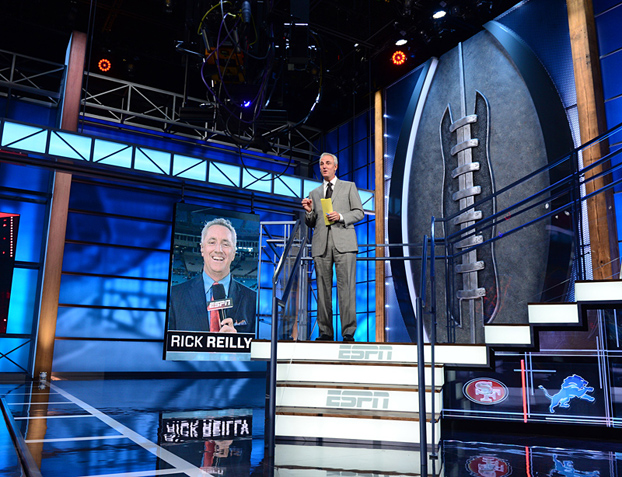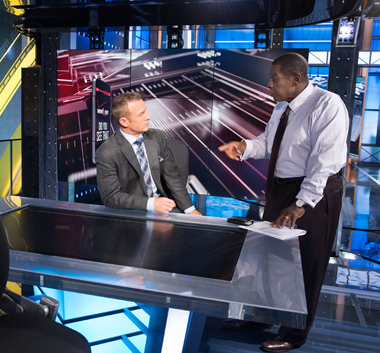Monitors Move in ESPN’s Studio W

Trey Wingo on the set of “Monday Night Countdown” (photo by Joe Faraoni / ESPN Images)
ALEXANDRIA, Va.—Cameras can move and so can the talent. However, when it came time for ESPN to do something different and eye-catching in its Studio W used for the network’s NFL programming, the set designers wanted more movement.
That’s why the studio now has dozens of on-camera monitors, including several that move on tracks to highlight the content. The project involved engineers and studio staff at ESPN, with the specialists from Jack Morton Design working with the network to create an overall look and “brand” for the studio.
The television systems were integrated by AV Design Services, which has its headquarters in Levittown, Pa., although the ESPN integration was run from the AVDS office in Burlington, N.J. In addition, the tracking and motion systems for the on-screen monitors were built by Yonkers, N.Y.-based Hudson Scenic.
All told, the studio has 55 displays, including two 82-inch and one 55-inch touchscreens, as well as 18 46-inch displays and 32 32-inch displays. Not all of them are on tracks and moving, but several of them are.
Integrating all this involves several challenges, not the least of which is finding cable that can withstand repeated motion and flexing.
“It was imperative that we supply the highest quality cable for this project,” said Jim Landy, the founder and managing partner for AV Design Services. “First, we wanted to ensure that we future-proofed the installation as much as possible for 4K. With all of the moving display items on site, we needed to research and locate superior quality flex cabling for signal (Cat-6 and HD-SDI) and power distribution cables that were rated for HD/4K signal and 100K-bend capability.”
The professional video industry's #1 source for news, trends and product and tech information. Sign up below.
The video cable chosen for the project turned out to be Belden CatSnake Cat-6A cable (Belden part number 1302E).
HAMMERING OUT THE DESIGN

Merril Hoge (l) and Tom Jackson on the set of “Sunday NFL Countdown” (photo by Rich Arden / ESPN Images)
AVDS won the bid on the project in January 2014, and immediately set about hammering out the design. The integration was complete by August 2014, in time for this year’s NFL season. All integration was done in the field with the exception of tracking mechanisms, which were supplied, installed and calibrated by Hudson Scenic.
To say that integrating moving displays into a studio is challenging is an understatement, especially a studio with as high a profile as ESPN’s primary NFL origination facility.
“Any time a designer asks an integrator to provide moving displays, whether those displays are LED or flat-panels, the hardest part is always the tracking alignments between displays,” Landy said. “There are very tight tolerances for spacing between 2.5mm, 3.9mm LED displays and/or “seamless” flat panel monitors (typically 3.5mm for newer flat-panels). Making those alignments between display devices is very critical when you are talking a millimeter or two between displays. We worked with Hudson Scenic on alignment of the motorized LED display pieces in Hudson’s shop for weeks before it was installed on set and realigned again. It was very time-consuming but the end result is worth the effort.”
Perhaps the most impressive part of this complex project that involves motorized monitor motion is that it all works reliably and looks great on camera. To Landy, however, it was just an interesting set of problems to be solved.
“When you take the time to engineer the project properly with the ESPN engineering and technical teams prior to time on site, surprises are limited to a few design oversights,” he said. “But typically, the process went very smoothly.”
Best of all, Landy said that the project came in on budget and on time, which he found rewarding. He attributes the smooth installation to the responsible team members, although having a good plan and coordinating frequently played an important role in getting the job done in time for fall 2014 football broadcasts.
Bob Kovacs is the former Technology Editor for TV Tech and editor of Government Video. He is a long-time video engineer and writer, who now works as a video producer for a government agency. In 2020, Kovacs won several awards as the editor and co-producer of the short film "Rendezvous."

